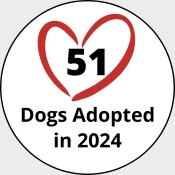Bonding with the Adult Rescue Dog
© By Charlotte Mielziner
Professional Member, APDT
Certified in Canine Behavior, Purdue University
Certified Private Trainer, ABTA
Rally Judge, AKC and MBDC
Carolyn was frustrated. The lovely 6 year old border collie she fell in love with and brought to her home was not the affectionate, loyal companion she had expected. In all fairness, he was housebroken, gentle with the cat and walked nicely on lead, but it was something else. He would come forward for a treat, take it and back away. In the evenings, he would lay behind a rocker in the corner and stare at her. He only approached her when he wanted her to throw a tennis ball. He frankly seemed better friends with the cat than her. Why didn’t he seem to like Carolyn?
The species from which dogs descended, the wolf closes its socialization window around the age of four to six months and rarely allows anyone else in their circle of friends for the rest of its life. Luckily, the dog remains pliable enough in its emotional makeup to bond at any age, but it can take longer once they are an adult. How long? It depends on many different factors. The age of the dog, its prior experiences, temperament, the new caretaker’s ability to provide leadership and consistent interaction. We cannot predict how and when a dog will finally bond with their new owner. Sometimes, they give their hearts with the first bowl of kibble, or it may take a month or more. Be patient, there are things you can do to assist this process.
- Be the stable thing in your dog’s environment. Be the person he can count on being there. Take him everywhere you can. Walk in the park today, stroll down a nature trail tomorrow and errands the next day. You must be the predictable thing he can count on. You will become a pack of two, dedicated to each other in all life’s adventures.
- Take an obedience class. Even when your dog seems like he pays good attention and obeys basic commands, an obedience class is the single best method to help new owners learn to communicate and bond with their dog. It is also the safest venue to begin socializing your dog with other dogs. In just a few weeks, dogs go from lunging, barking whirlwinds of energy to calmer, focused partners with their handlers. An obedience trained dog is welcome in more places and has greater freedom in the home. But, be careful who you go to. Work only with dedicated, professional positive motivation trainers.
- Use a house lead to keep in contact with your dog and he with you. Many rescue dogs may spend a lot of time by themselves, in a crate or under a chair. It is as if they don’t feel welcome yet. A house lead is a six to ten foot lead that attaches to a buckle collar, not a training or prong collar, you always hold the other end. Keep the dog on lead as many hours as possible and he is to go with you where ever you go in the house. If he is napping and you want a drink of water, he is to go with you. A house lead is also a wonderful tool for seeing to it the dog stays out of trouble until he learns the house rules.
- Touch your dog and speak to him as often as possible. The need for touch is just now being recognized for its comfort and as a method of unspoken reassurance. Stroke him as you put a bowl of kibble down, as you put on the lead and before you give him a treat. Bathe or brush him yourself, talking all the while about what a great dog he is. Make physical contact from you a pleasant thing by finding his favorite itchy spots and giving them a good scratch. You may even sit on the floor with him for a while each evening and give him a nice massage.
- Play with your dog. This does not mean sitting in a lounge chair and throwing a tennis ball for two minutes while you watch TV. Get up and move, give the dog your full attention. You may try having several tennis balls and as the dog goes for one, turn and run a few steps and throw another. Playing means getting a really good game of tug going, smiling, laughing and moving around with it. Truly have a good time playing.
Carolyn wisely chose to put all five of these tips into play. Some adopters can tell the moment their dog realizes he is truly in his forever home. She does not know when her dog finally bonded with her, but he did. She does remember the first time she said his name and he wagged his tail, “I knew we were on the right track!” He looks to her for reassurance, leadership and just plain fun. She thinks in this case, it was a process that took place over time. She says, “We sort of bonded with each other.” Trust grew and a real friendship between the human and the dog evolved as they shared adventures.
Today, Carolyn proudly states she regularly takes her border collie to a local nursing home as a therapy dog. Each morning, he watches closely as she gets ready for the day and waits for her gentle kiss on his nose. He dozes in the evenings with his head on her foot, so that when his special human should move he can be there, living life forever with his best friend.
You are welcome to use this article but please give credit to Charlotte Mielziner and Mo-Kan Border Collie Rescue. Please let us know by emailing us!


